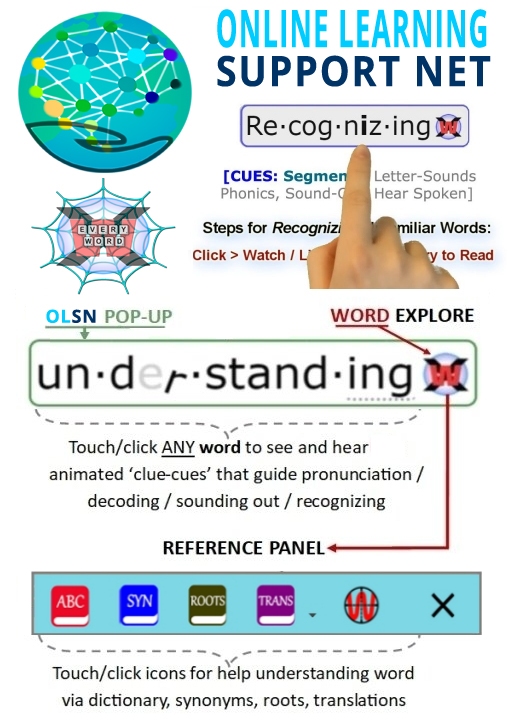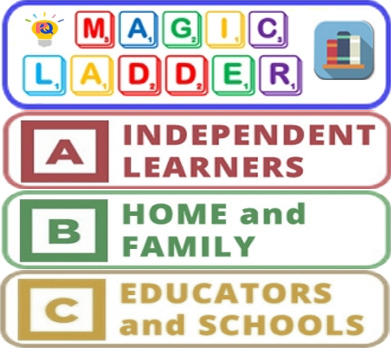Early Language Development
Newborns have an innate capacity to differentiate speech sounds that are used in all the world’s languages, even those they have never heard and which their parents cannot discriminate. But later in the first year they lose this ability as they become perceptually attuned to the language they will learn. – Dr. Ross A. Thompson, Developmental Psychologist, University of California, Davis – National Scientific Council on the Developing Child. Source: http://www.duboislc.org/EducationWatch/ShapingBrainsOfTomorrow.html
Note: Remember to click on any word on this page to experience the next evolutionary step in technology supported reading.
Normal Nutritive Experience
Brains come in to the world, so to speak, expecting to be bombarded with language at an early age as part of their organizing principle, and human brains that don’t get that experience, in effect, are not getting the normal nutritive experience ….
Terrence Deacon, Professor of Biological Anthropology and Linguistics at the University of California-Berkeley. Author of The Symbolic Species: The Co-evolution of Language and the Brain. Source: COTC Interview – http://www.childrenofthecode.org/interviews/deacon.htm#AcquiringLanguage
Brain’s Listening Dominated by Language
Dr. Michael Merzenich: … in the human case, the listening experience of the brain is overwhelmingly dominated by language experience. It’s a powerful, language is an incredibly powerful, experential source in the average kid.
A Dutch scientist counted the words that his child had heard by the time he was nine months of age and he found the child has been in the presence of about four and a half million words, of which about half a million had been spoken to the child. The child had actually had half a million words directed to him, of which about fifty thousand were produced in highly exaggerated form, in parent-ese, where the parent is talking in baby talk to the baby so the child maybe can follow the speech a little more clearly. That’s before the child puts the meaning to the first word. That’s massive experential exposure.
Now you and I know families at which that same moment in time, a child may have not been in the presence, except maybe on the television, of fifty thousand words. Does that make a difference? Very probably. It very probably makes a difference and the more the parents are interacting with a child, in a sense, the more that the received speech means to the child, probably the greater value it has as a training signal. It will make a difference. Sound experience in a child will make a difference. The way the processor of the brain will be set up will be largely dominated to specialize for the native language the child is exposed to because that sound exposure is so massive and so special in the history of learning in the child.
David Boulton: It is so central to everything they’re listening for in order to pull themselves into their world.
Dr. Michael Merzenich: Absolutely, and it becomes so quickly massively rewarding. I mean it has this wonderful aspect that it becomes a main source of reward for the child, moment by moment in time in life.
Michael Merzenich, Chair of Otolaryngology at the Keck Center for Integrative Neurosciences at the University of California at San Francisco. He is a scientist and educator, and found of Scientific Learning Corporation and Posit Science Corporation. Source: COTC Interview – http://www.childrenofthecode.org/interviews/merzenich.htm
Early Acoustic Processing Abilities
So, these early acoustic processing abilities set our brain up for how we’re going to organize the incoming world. We need our own physical environment to stimulate our brains and for language users, in order to break the code for language (which ultimately is a phonemic code, at least for the English language; it’s very much a phonemic code for our written language as well) we need to be able to organize the sounds that we hear very quickly in time because the acoustic changes that tell us which speech sound we have just heard are frequency and amplitude changes that occur quickly in time.
Paula Tallal. Board of Governor’s Chair of Neuroscience and Co-Director of the Center for Molecular and Behavioral Neuroscience at Rutgers University Source: COTC Interview – http://www.childrenofthecode.org/interviews/tallal.htm#ExperienceDependantBrainDevelopment
Consonants, Vowels and Word Learning
Dr. Reid Lyon: On the neuroscience side we know that little ones’ brains are moving much more robustly than we ever thought. As you know, at six months of age every kid who’s coming along okay in every culture, using every language, can receive and produce every consonant and vowel of every language, even if the language they will ultimately use doesn’t contain those consonants and vowels. That’s a hefty brain. We know that kids by eighteen months of age will start to learn nine new words a day, at least every day. Amazing. It’s an amazing proliferation of not only neuronal capacity, but also of the behavioral stuff that the neurons push.
G. Reid Lyon, Past- Chief of the Child Development and Behavior Branch of the National Institute of Child Health & Human Development, National Institutes of Health, Current senior vice president for research and evaluation with Best Associates. Source: COTC Interview – http://www.childrenofthecode.org/interviews/lyon.htm#Mostofourchildrenfated
An Association Between Mother’s Speech Clarity and Infants Speech Discrimination Skills
The results of this experiment demonstrate a highly significant positive correlation between maternal speech clarity and infant speech perception performance. This reasoning is compatible with recent findings showing that higher levels of speech discrimination in individual infants early in life significantly predicts advanced later language skills (Benasich & Tallal, 2002; Molfese & Molfese,1985; Molfese, 2000; Tsao et al., 2003), suggesting that efficient phonetic processing early in the first year of life assists subsequent language development. The data provided here, demonstrating a relationship between maternal speech clarity and infant speech perception, allow one to advance the argument that during this early formative period of development, higher clarityin maternal speech assists infants in discovering the appropriate acoustic cues and developing neural networks that code this information.
Huei-Mei Liu, Patricia K. Kuhl and Feng-Ming Tsao, Center for Mind, Brain, and Learning and Department of Speech and Hearing Sciences, University of Washington, USA. Source: http://ilabs.washington.edu/kuhl/pdf/Liu_Kuhl_2003.pdf
Caregivers’ Contingent Comments to 9 Month Infants: Relationships with Later Language
Total number of words mother’s used at 9 months predicted vocabulary – Further, we found, on average, the total number of words mothers used in 10 minutes predicted children’s vocabulary comprehension at 12 months, controlling for age (r=.87, p=.004). The pattern of results, however, suggested that mothers’ total number of words while engaging in caregiver contingent comments was driving the effect. Specifically, vocabulary comprehension at 12 months of age was associated with mothers’ total words when engaging in contingent comments at 9 months (r=.89, p=.004), but not mothers’ total number of words within other child-centered acts and child-directive acts.
Pamela Rosenthal Rollins, University of Texas at Dallas – Callier Center for Communication Disorders (in press, Journal of Applied Psycholinguistics) Source: http://www.utdallas.edu/~rollins/ccc_paper.html
Maternal Speech, Rather Than Socieoeconomic Status, Affects Early Vocabulary Development
Regardless of SES, more complex and richer maternal speech was associated with more rapid vocabulary development in children. The central finding of this research was that the effects of the complexity and richness of their mothers’ speech fully explained the SES-related difference in the children’s vocabulary use.
Summarized from Child Development, Vol. 74, Issue 5, The Specificity of Environmental Influence: Socioeconomic Status Affects Early Vocabulary Development Via Maternal Speech by E. Hoff. Copyright 2003 The Society for Research in Child Development, Inc. Source: http://www.srcd.org/journals/cdev/1-1/Hoff.pdf
Shaping the Brains of Tomorrow: What developmental science teaches about the importance of investing early in children
Newborns have an innate capacity to differentiate speech sounds that are used in all the world’s languages, even those they have never heard and which their parents cannot discriminate. But later in the first year they lose this ability as they become perceptually attuned to the language they will learn. By age 3, a child is forming simple sentences, mastering grammar, and experiencing a “vocabulary explosion” that will result, by age 6, in a lexicon of more than 10,000 words.
Ross A. Thompson, Developmental Psychologist, University of California, Davis – National Scientific Council on the Developing Child. Source:http://www.duboislc.org/EducationWatch/ShapingBrainsOfTomorrow.html
The Development of Symbol-Infused Joint Engagement
We found the developmental path of symbol-infused joint development began at 18 months when toddlers readily communicated with their mothers about immediate objects and events, rose rapidly over the next six months, then plateaued at 30 months, when symbols were routinely integrated into most interactions. This path varied depending on when a toddler began to speak.
Toddlers who were relatively early language users sustained symbol-infused engagement more often than their peers. In contrast, toddlers with very limited vocabularies at 18 months were less likely to sustain symbol-infused interactions, although they did gradually catch up to other children. Not surprisingly, we found that language skills at 18 months predicted language use at 30 months. More interestingly, we found that knowing how often toddlers sustain symbol-infused engagement from 18 to 30 months significantly increased our capacity to predict variations in latter language skills.
L.B. Adamson, R. Bakeman, and D.F. Deckner, Georgia State University. Source: http://www3.interscience.wiley.com/journal/118748677/abstract?CRETRY=1&SRETRY=0
Longitudinal Relations Between 2-Year-Olds' Language and 4-Year-Olds' Theory of Mind
Individual differences in child language at 24 months and child verbal IQ at 48 months predicted unique variance in performance on the false-belief tasks at 48 months, although only the early language factor findings were statistically significant. These findings demonstrate previously unobserved relations between early language and later acquisition of complex concepts related to mind.
Anne C. Watson, Kathleen M. Painter, Marc H. Bornstein Journal of Cognition and Development, 2001, Vol. 2, No. 4: Pages 449-457. Source: http://www.leaonline.com/doi/abs/10.1207/S15327647JCD0204_5
School Outcomes and Differences in Early Language Exposure
Dr. Todd Risley: We gave all of the children the Stanford-Binet IQ Tests at age three. The relationship between the amount of talking they heard, amount of parent talk, was related .6 to the child’s vocabulary size. Now, when we refine that look, where we eliminate the business talk and only look at the extra talk, the extra talk above business talk, as correlated with the Stanford-Binet IQ Test, was related to the child’s IQ test scores by .78. Now, you can’t get any higher than that because remember the test/retest reliability of the Stanford-Binet is .81.
David Boulton: That’s about a strong a correspondence as you could get.
Dr. Todd Risley: Our test reliability was .967, something like that, depending on what you measure. So, you multiply those two together and that’s as much of the variance as you can get out of that data – a ‘strong’ relationship.
Todd Risley, Professor Emeritus of Psychology at the University of Alaska. Co-Author “Meaningful Differences in the Everyday Experience of Young American Children.” Source: COTC Phone Interview – http://www.childrenofthecode.org/interviews/risley.htm#OutcomesofDifferences (Note: The phone interview transcript does not match the video interview verbatim. The previous quote was taken from the video interview.)
The Detailed Age Trajectory of Oral Vocabulary Knowledge: Differences by Class and Race
Data from the Children of the NLSY79 (CNLSY) are pooled together across survey waves, 1986–2000, to provide an unusually large sample size, as well as two or more observations at different time points for many children, recorded at single months of age between 36 and 156 months. We fit a variety of multilevel growth models to these data. We find that by 36 months of age, large net social class and Black–White vocabulary knowledge gaps have already emerged. By 60 months of age, when kindergarten typically begins, the Black–White vocabulary gap approximates the level it maintains through to 13 years of age. Net social class differences are also large at 36 months. For whites, these cease widening thereafter. For Blacks, they widen until 60 months of age, and then cease widening. We view these vocabulary differences as achieved outcomes, and find that they are only very partially explained by measures of the mother’s vocabulary knowledge and home cognitive support. We conclude that stratification studies as well as program interventions should focus increased effort on caregiver behaviors that stimulate oral language development from birth through age three, when class and race gaps in vocabulary knowledge emerge and take on values close to their final forms.
Children are trained up to the family-specific pattern of language use, and it is variation in those family-specific patterns that largely determine the different vocabulary trajectories observed for children of different social classes.
George Farkas, Department of Sociology, Pennsylvania State University and Kurt J. Beron, School of Social Sciences, University of Texas – Social Science Research 33,3 (September 2004) Source: http://www.nlsbibliography.org/qauthor.php3?xxx=BERON,+KURT
Use of Videotaped Interactions During Pediatric Well-Child Care to Promote Child Development: A Randomized, Controlled Trial
The authors performed a randomized, controlled trial to assess the impact of the Video Interaction Project (VIP), a program based in pediatric primary care in which videotaped interactions are used by child development specialists to promote early child development. Ninety-three Latino children (51 VIP, 42 control) at risk of developmental delay on the basis of poverty and low maternal education (none had completed high school) were assessed for cognitive and language development at age 21 months. Results differed depending on the level of maternal education; the VIP was found to have a moderate impact on children whose mothers had between seventh and 11th grade education (approximately 0.75 SD for cognitive development, 0.5 SD for expressive language) but little impact on children whose mothers had sixth grade or lower education.
Mendelsohn, A., Dreyer, B., Flynn, V., Tomopoulos, S., Rovira, I., Tineo, W., Pebenito, C., Torres, C., Heidi, M., Nixon, A. Source: Journal of Developmental & Behavioral Pediatrics. 26(1):34-41, February 2005.
Sources of Child Vocabulary Competence: A multivariate model
This study examines sources of individual variation in child vocabulary competence in the context of a multivariate developmental ecological model. Maternal sociodemographic characteristics, personological characteristics, and vocabulary, as well as child gender, social competence, and vocabulary competence were evaluated simultaneously in 126 children aged 1;8 and their mothers. Structural equation modelling supported several direct unique predictive relations: child gender (girls higher) and social competence as well as maternal attitudes toward parenting predicted child vocabulary competence, and mothers’ vocabulary predicted child vocabulary comprehension and two measures of mother-reported child vocabulary expression.
p>Bornstein MH, Haynes MO, Painter KM. Laboratory of Comparative Ethology, National Institute of Child Health and Human Development, National Institutes of Health, Bethesda, MD 20892-2030. Source: http://www.ncbi.nlm.nih.gov/entrez/query.fcgi?cmd=Retrieve&db=PubMed&list_uids=9770912&dopt=Abstract
The Home-School Study of Language and Literacy Development
Importance Of Preschool Era For Developing Skills Relevant To School
In a series of analyses, we were able to predict the children’s scores on emergent literacy, vocabulary, and narrative production on the kindergarten SHELL (the School-Home Early Language and Literacy battery; see Snow et al. (1995)), from a variety of sources, including home interview information concerning home support for literacy, as well as some measures of decontextualized language and rare word use by mothers; classroom quality, extended talk, and vocabulary in preschool; and classroom quality in kindergarten. In combined regression analyses, science process talk, home support for literacy, and kindergarten classroom quality explain 35% of the variance in the scores on the narrative production task; home support for literacy and rare words in mealtimes and toy play explain 27% of the variance in emergent literacy; and home support for literacy, rare words at mealtimes and toy play, and kindergarten classroom quality explain 50% of the variance in the vocabulary measure (Dickinson, Snow, Roach., Smith, & Tabors, 1998).
Co-Principal Investigator: Catherine E. Snow, Ph.D., Co-Principal Investigator: David K. Dickinson, Ed.D., Research Coordinator: Patton O. Tabors, Ed.D. Source: http://www.gse.harvard.edu/~pild/homeschoolstudy.htm













